Why… do we need to change?
Not meeting:
- Customer requirements (internal/external)
- Goals
- Targets
- Deadlines
- Budgets
Need for:
- Revenue
- Competitive advantages
- Innovation
- Application of best practices
- New skills
- Economic adjustments
Why… do we need change management?
Why do people resist change?
Individuals are typically resistant to change. Why?
10 Reasons people resist change:
- Fear of the unknown
- “We’ve tried this before.”
- “Is there really a need for change?”
- Lack of information
- Lack of resources
- Loss of security
- Loss of power
- Poor timing
- Habit
- Too many responsibilities/special projects
The workforce wonders…
- Is this just another program?
- Is this the ‘flavor of the month?’
- What’s in it for me?
- How can I do this on top of everything else?
What strategies can be employed to facilitate change?
Common Mistakes organizations make:
- Focus
- Effort is not focused on the customer
- Focus is on products or services and not processes
- Goals, Measurement and Results
- Goals are set too low
- Results are not obtained quickly (need quick wins)
- ‘Paralysis by analysis’
- Overwhelming data collection & analysis
- Data not adding value to the process
- Personal
- Quality is a personal commitment
- Reward systems are not in place
Common Mistakes organizations make:
- Senior management is not driving it…living it
- Silos: organization does not see itself or operate as a collection of interrelated processes
- Little real empowerment is seen
- The culture remains one of ‘command and control’
- Training is not addressed
- Organization is too complacent
- Misalignment with the mission & vision
Keys to success
- Buy into what you are selling
- Buy-in yourself
- Gain buy-in from top management
- Foster an entrepreneurial / ownership attitude
- Enable risk taking
- A simpler plan is better
- Use a stepped or phased approach to make it
- manageable, with clear action plans
- Set measurable, attainable goals
- Establish a sense of urgency
The more people on the bus the better!
- Identify “Change Agents” – those that readily accept change and can promote change to get people on the bus.
- Choose Change Agents that are:
- Influential
- Doers
- Get them excited about the changes.
- Gain support from management
- Physical
- Emotional
- Resources
Gaining and maintaining momentum early will yield greater successes later.
- Plan for “Quick wins”
- To provide early momentum for change
- To get people on board
- To foster excitement
- Use benchmarks
- and benchmark organizations
- If it can be done by others, it can be done by us
- Identify:
- Milestones
- Timelines
- The finish line
- Recognize /Reward along the journey
5 ‘I’s: Key Mechanisms for Overcoming Resistance
- Information – educate; dispel uncertainty and fear
- Indoctrination – make changes seem inevitable
- Intervention –
- Communication strategy/plan (groups; one-on-one)
- Provide/acquire resources
- Contingency plans
- Involvement
- Make people part of the solution
- Negotiation and agreement
- Incentives
- Share positive incentives
- Share negatives if change does not occur
- Get naysayers off the bus (early)
The Transformational Change Model
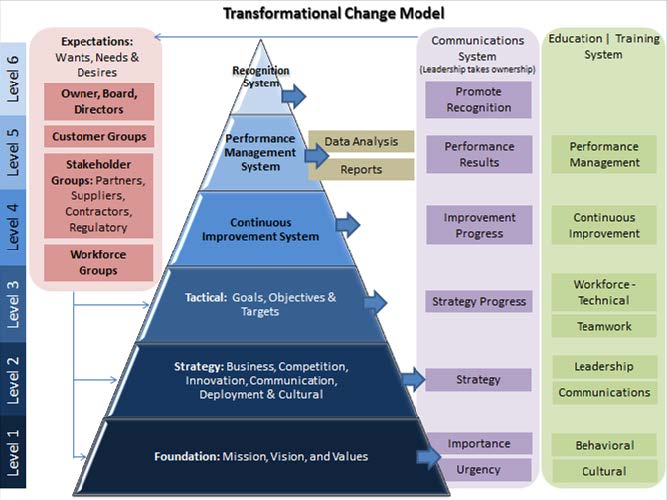
The Model
6 Levels
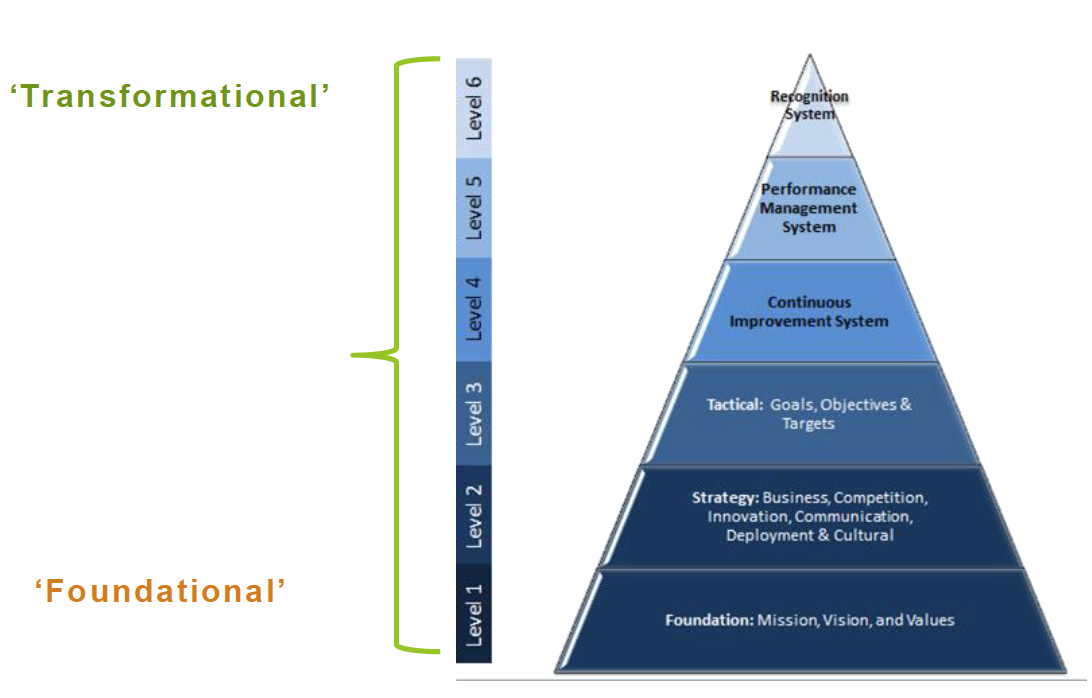
The need for change starts and ends with the customer.
- Know your Customer AND stakeholder expectations
- Involve them with your Strategies and tactics
- Balancing the needs of customers AND stakeholders is important.
START HERE
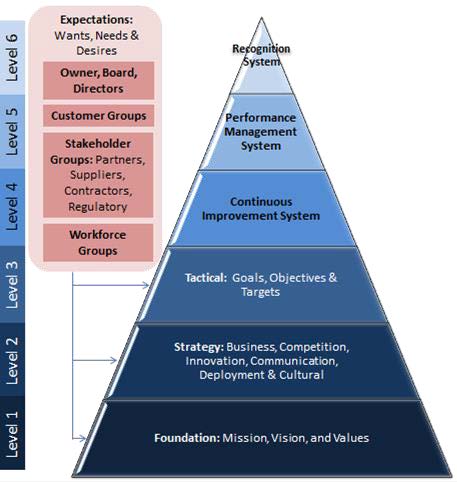
For most companies communication is the number one concern.
- From workforce surveys
- Have a parallel communication system aligned with your levels.
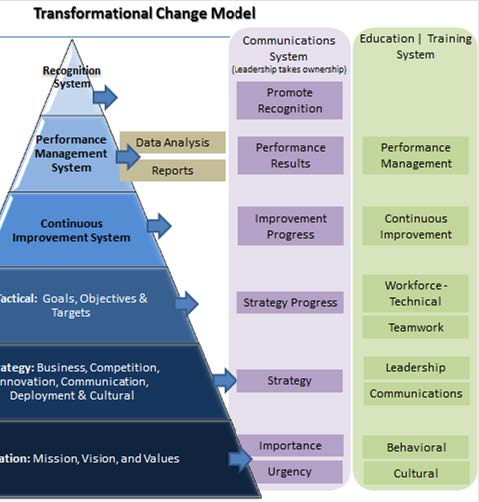
- An Education System is needed to support transformational change.
- Ask.
- Make it SYSTEMatic. (More on this later)
Workforce competency improves change acceptance.
A strong foundation is fundamental to begin the change process.
Such a foundation includes developing:
- A Mission
- A Vision
- Strong Core Values
Leaders must create a sense of urgency.
- And maintain this urgency
- Significant emphasis is needed at the start
- Leaders must also communicate the importance …the ‘Whys’ for change
Education is needed to address cultural behaviors
- Observe behaviors
- Evaluate the culture for alignment
- Establish expectations early
Establishing strategies builds confidence.
- Stakeholder confidence
- Examples:
- Business improvement
- Process improvement
- Financial gains
- Competitiveness improvement
- Innovation
- Communications
- Deployment
- Cultural change
Strategies need plans for implementation
- Possible strategic plan components:
- Implementation Plan
- Communications Plan
- Education/Training Plan
- Performance Management Plan
- Cost Management Plan
- Stakeholder Management Plan
- Contingency / Scenario Plan(s)
The Strategic Plan must be communicated and referred to nearly constantly.
- Emphasize:
- Roles
- Responsibilities
- Expectations
- Accountability
Leadership, managers and the workforce need to understand…
- The strategy
- The planning and implementation process
- The communications process
- Therefore, education and training is imperative.
Supervisory / middle management is the most critical level.
- They translate the strategy to the workforce.
- Middle managers must be targeted for understanding and commitment.
Tactical plans should align with the strategic areas.
- Tactical plans should include goals and objectives.
- Actions should align with the major tactics.
For momentum and buy-in, continuous sharing of progress is critical.
- Multiple forms of communication are needed.
- Workforce segments require (want) varying communication.
- Ask.
Tactical actions require teamwork.
- Teambuilding
- Technical competencies are essential as well.
- A plan is needed to provide technical skill training for the workforce.
Continuous improvement systems are required to implement strategy.
- System examples:
- Plan-Do-Check-Act
- Lean Six Sigma
- Project management
- Improved processes need to be ‘SYSTEMatic.’
Again, for momentum results need to be shared (constantly).
- Results examples:
- Performance indicators
- Measures/metrics
- Satisfaction levels
- Scheduled accomplishments
- Milestones
- New processes/programs
The understanding of continuous improvement systems are often unknown.
- Yet, teams are expected to apply them.
- Education and training is needed on the effective use of:
- Such processes/systems
- Tools used and available to deploy such systems
See SYSTEMatic presentation.
‘What gets measured gets managed, and what gets managed gets done.’
- Strategic Key Performance Indicators (KPIs)
- Performance Indicators (PIs) also need to be:
- Rolled-up into KPIs (hierarchy)
- Leading and lagging indicators
- The most critical piece.
The best arranged plans are only qualified through performance results.
- A diligent and disciplined focus on performance is needed.
- Data should be analyzed and the results shared.
- A SYSTEMatic reporting program is crucial.
Managers and the workforce need to be able to appropriately interpret and understand results.
- Therefore, education and training is required regarding performance management.
‘…what gets rewarded gets repeated.’ – John Schnatter, founder of Papa John’s
- A ‘SYSTEMatic’ reward and recognition program is essential.
- A focus is needed in multiple areas, from multiple directions.
- Leadership must make this a habit AND be directly involved.
Considering the criticality of recognition…
- Leadership needs to communicate the importance and frequencies
- High expectations must be set
Learning should be used as an input into establishing future expectations.
- Learning occurs through the communication processes;
- So, communication should be two way.
- Rolled back into continuous improvement
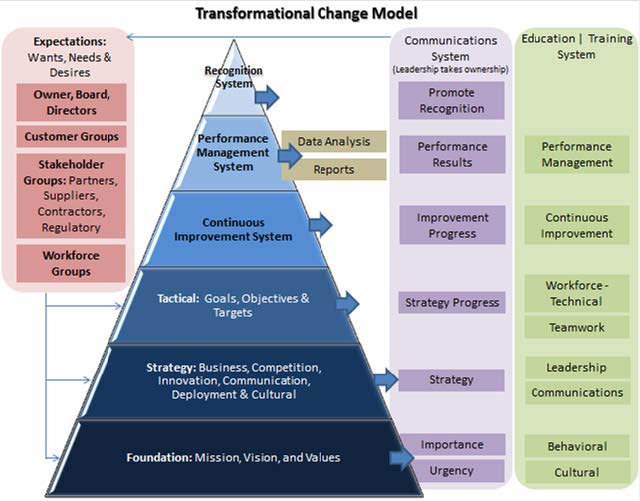
In Summary
- A holistic and systematic approach is necessary for effectively changing the culture of an organization
- Missing of even one piece of the model can result in drastic reductions of effectiveness
- Approach development and deployment one step and one level at a time
www.CompetitiveEdgePerformance.net
Contact Information:
CompetitiveEdgePerformance.net
Rick Bickerstaff
Rick@CompetitiveEdgePerformance.net
843.297.2596
For more information, please feel free to contact us!


Comments are closed.